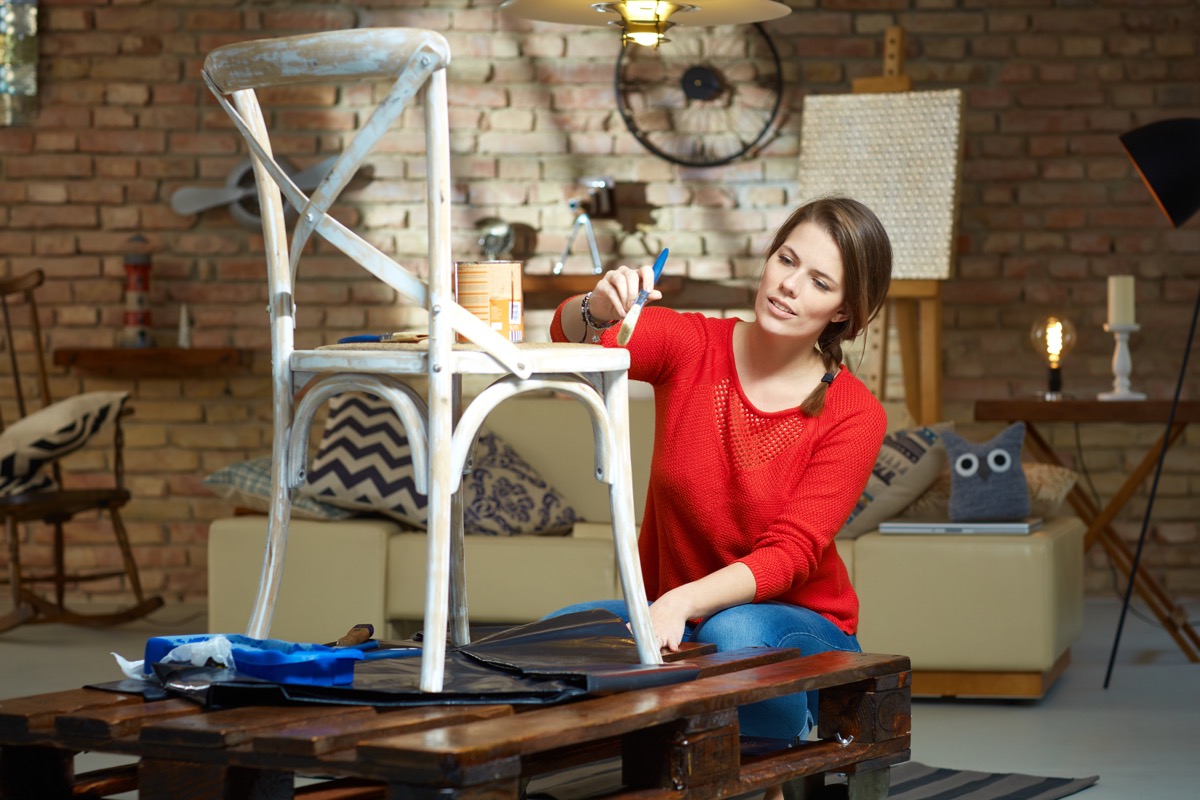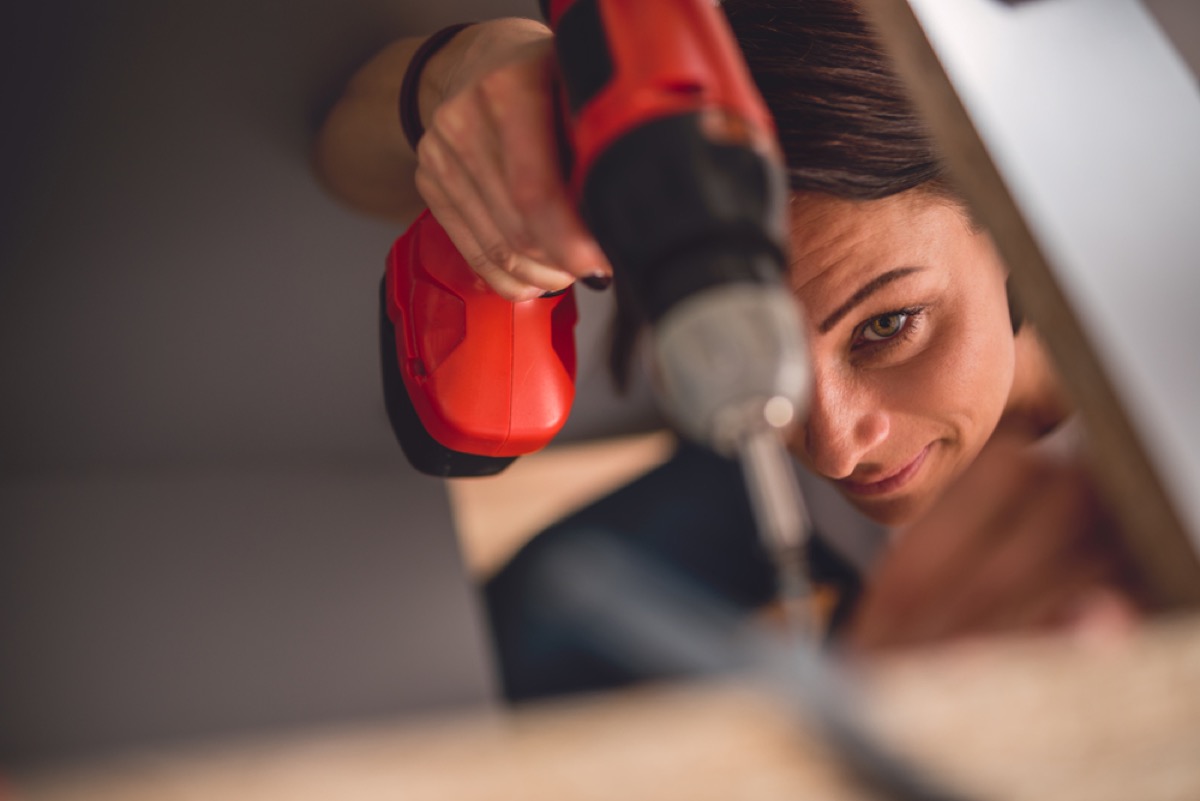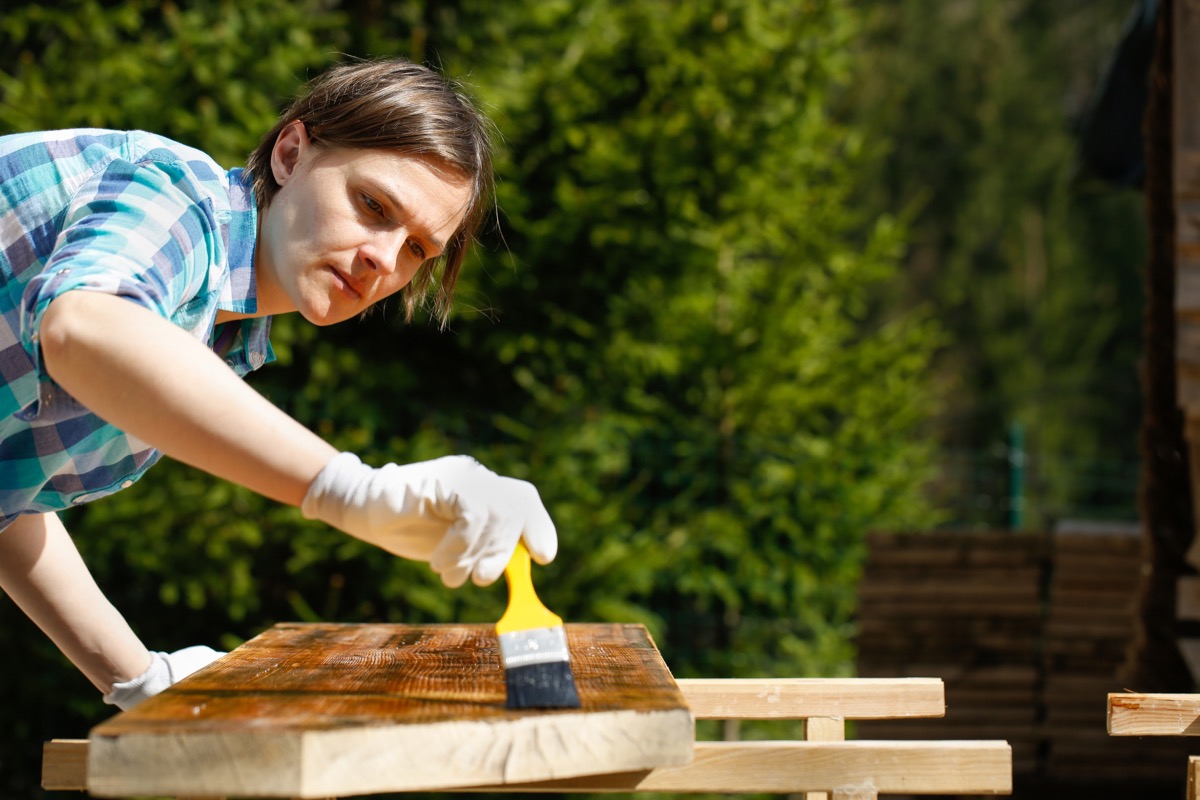33 Common DIY Mistakes You’re Probably Making, According to Experts

Customized furniture. Upcycled vintage tchotchkes. Beautiful wall hangings. The world of DIY is truly limitless. The idea is to save money while expressing your uniqueness and creativity—and the results can be pretty spectacular, especially with the knowledge that you made something awesome with your own bare hands. But before you whip out the paint and plywood, there are a few things to keep in mind, especially if you want to avoid the most common DIY mistakes.
If you’re new to DIYing, it’s easy for projects to get out of hand. So, to get an idea of the types of missteps you should avoid with your DIY projects, we talked to our favorite DIY experts who know how to do it all themselves and make it look great. Here, they’re sharing their best advice so that you can start your project on the right foot and be thrilled with the results. Read on and get ready to build, paint, and create with ease by avoiding these classic DIY mistakes.
1
Being ignorant about your materials

Not all material is created equal, according to the team at DIY and craft site Lia Griffith. Instead of going into your project blindly, make sure to look up your materials just in case they need some particular tender loving care.
For instance, “when it comes to crepe paper, the two most common mistakes we see are not cutting on the right grain and not stretching the paper when shaping,” they explain. And for some life-changing DIY tips for your home, check out 50 Easy DIY Home Hacks That Will Improve Your Life.
2
Especially when it comes to your paint

Acrylic paint is not the same as watercolor paint or wall paint. “Do your research to determine the best paint for the surface you are painting,” says DIY and craft expert Lynn Lilly of Craft Box Girls. “There are specific paints for raw wood, cabinets, plastics, outdoors, brick, etc.” If you use the wrong type of paint, it might not stick to the surface or there’s a chance it could chip.
3
Not utilizing paint chips

Paint chips are your best friend when it comes to DIY. Before you commit to a paint color, grab some paint chips or sample paint tins for your project. “Paint chips are a great resource,” Lilly says. “But paint will always look slightly different on the wall or surface depending on the surface material and lighting.” When in doubt, go a shade lighter than you think you might need. Paint always dries darker, particularly if you use several coats.
4
Defaulting to white

There’s a time and a place for a good white-painted DIY. But according to the experts at Lia Griffith, too much white can be a problem. “White furniture and walls can look dirty or dingy quickly,” they warn. Instead, look into unexpected paint shades, invest in trial paints, and try wallpaper options before settling for white.
5
Skipping the sanding

If you’re not too familiar with wood, you might not realize that staining or painting it requires some sandpaper first. This is a vital step, according to Lilly, because it strips the surface of its finish so that the paint or stain can penetrate the wood. “Proper prep will provide a longer lasting finish,” she adds.
6
Not testing on scraps

If you’re worried about starting your project on the right foot, the team at Lia Griffith suggests testing with leftover DIY scraps. This means you won’t ruin the materials you spent valuable money on, but you’ll get a feeling for the potential end product.
7
Forgetting about safety

Sometimes, DIY projects can get a little messy and a little dangerous. Jessie Ecker of DIY site Eye in the Detail encourages safety gear whenever possible. “Face masks, eye protection, hair tied back, safety boots, all the things,” she says.
Not only will all that gear protect the outside of your body, but your lungs as well. “Did you know sawdust never leaves your lungs?” she warns.
8
Neglecting prep work

“I am actually often a culprit for this mistake,” Ecker admits. “The projects that I really put the prep work into always go so much smoother, quicker, and cheaper.”
The best way to keep yourself from making this mistake? Budget planning time into your project and keep a notebook so that you can make notes about what you’re planning and what you’ll need before you get started.
9
Shopping without a list

Just like with grocery shopping, you’ll want to make a list before you head to the hardware or craft store for your next DIY project. Wandering the aisles aimlessly could lead to buying things you don’t need—or worse, forgetting things entirely. “Not having the right tools and supplies could possibly double your project’s completion time,” says Bianca White, founder of the DIYher Workshop. A clearly defined shopping list will help prevent multiple trips to the store.
10
Being too conservative with material

When you’re doing a project for the first time, you might not know exactly how much material you’ll need, especially if your tutorial doesn’t break it all down. To avoid running out, White suggests shopping smarter. “It is better to buy more of it than not enough. You can always return the excess later on as long as you keep your receipt,” she says. And if you’re particularly nervous about losing it, take a picture of your receipt as backup.
11
Not taking measurements first

“Measure, measure, measure!” White says. Before you even go to the store, take measurements, write them down, and, to be extra careful, bring a measuring tape with you when you go shopping. “Measure your space or item twice so you can make double sure your finished product will turn out perfect,” White says. It only takes an extra minute or two when you really think about it!
12
Not prepping your work surface

It might seem like a safe bet to just use your bed or a dining table as your work surface, but that’s not the best idea. According to White, not preparing a work surface can lead to longer clean-up time. Even worse though, there’s also the potential that you could cause damage. “If you do not have access to a large roll of plastic, use old towels to protect your floors, walls, and furniture,” White adds.
13
Taking shortcuts

Shortcuts can be deceivingly simple; don’t fall for the appeal. “DIY saves you money, but taking too many shortcuts or cutting corners is never worth it in the long run,” says Cara Newhart of the DIY blog Never Skip Brunch. Understand that some steps take longer than others, and that’s all part of the experience when you’re making something by hand.
14
Stretching yourself beyond your limits

“Take on projects that stretch you,” Newhart says, but she warns that doesn’t mean you should push yourself too far. It’s OK to pause, step away, and re-evaluate whether you’re taking on a project that you’re not fully equipped for. That doesn’t mean you’re quitting—it just might mean that you’re giving yourself time to figure out if you want to pivot in a new direction.
15
Not going big enough

Going small in some aspects of your DIY project can be impactful, but don’t let this be the only way you create something. “Dive in and DIY big,” Newhart says. So instead of small patterns, try a larger one. Instead of a subtle paint or stain, go for something bolder that matches your personal aesthetic.
16
Being too careful

All of us experience the fatigue of doing the same DIY projects that’ve succeeded in the past. But now is the time to kick boring DIYs to the curb by switching things up. “Try something outside of your comfort zone and really go for it,” suggests Ecker. You never know what will happen! Just remember to educate yourself first by reading tutorials and watching videos of your new project.
17
Using your machinery incorrectly

If you’re creating your own vinyl lettering or felt decals, you’re likely using a cutting machine. But according to the experts at Lia Griffith, it’s easy to mess up if you’re not familiar with the technology. “When there are changes to the software, [it] can lead to getting easily frustrated with the technology before you even make a project,” they say. So be sure to update your software and read your user manual before hopping in.
18
Buying expensive tools

Perhaps you’ve been in this situation before: You gathered all of your materials to make a masterful DIY, you’ve read your tutorials, you’ve learned your new techniques, and then you realize that you can’t start because you don’t own a circle saw. Instead of purchasing an expensive tool like that, Ecker suggests hitting up your local hardware store to rent it by the hour or by the day.
19
Or not getting creative with tools

“Does having all the fancy tools make it easier? Sometimes. But they are definitely not needed,” says Leah Maria of Leah Maria Designs. For smaller projects, Maria says you can just use something simple like a screwdriver or a table saw. “That is how most of us start out. Just a few tools and some creativity,” she says.
20
Neglecting to build in buffer time

DIY projects take time. After all, they’re made completely by hand. So, if you’re new to DIYing, you might need a few more hours than whatever your tutorial lays out. “Always plan extra time so you don’t have to rush through the project and compromise results,” Lilly says.
21
Rushing through it

Speaking of timing with your DIY, “it can be hard to stay motivated when you think your project will take you a day and it turns into a week,” Maria says. Try to keep yourself on a timeline and remember, it’s OK to take breaks if your arm gets tired from painting. “You can bet the end result will be that much better because it wasn’t rushed,” she says.
22
Buying the cheap stuff

Sometimes, you might be able to get away with inexpensive materials. But doing so can also result in mistakes. “When I first started off DIYing, I wanted to do it for the cheapest amount possible. After all, I was doing this to save money,” Maria says. “I quickly learned that was a mistake. Having quality materials will make your life so much easier.” And considering it might only be a dollar more for a better quality paint brush, it’s well worth it.
23
Flying solo

You don’t have to go into your DIY project alone. “Having two sets of hands on a job can make life so much easier,” Maria says. Not only will friends be able to make things go quickly and smoothly, but they might be able to offer you advice that you hadn’t considered before.
24
Going in blind

Everyone needs a place to start. From videos to free printouts and blogger tutorials, Google can offer you insight through the eyes of experts—especially when you’re diving into a DIY project you’ve never done before. “People don’t realize the power of Google and the teaching capability it has,” says Kelly Ballard of DIY design site City Girl Meets Farm Boy.
25
Not consulting social media

If you’re feeling particularly uninspired, head over to social media platforms like Pinterest and Instagram to look at expert DIY projects for a brain boost. And don’t be afraid to reach out to other creators for their words of wisdom, either. “Most people are surprisingly eager to talk about their DIY experiences, both good and bad,” Maria says.
26
Not putting your own twist on it

“It’s great to start a DIY project with some inspiration in mind, but it’s your unique customization that can totally take your piece to the next level,” artist and illustrator Allie Folino advises. Think of your project as a way to truly express your creativity—even if you’re not the most artistic person out there. “It’s often the uniqueness of art, and the fact no one can replicate that exact piece, that makes it all the more compelling,” she adds.
27
Hesitating

“People are always afraid to start,” says Ballard. “They let the fear of uncertainty stop them from starting.” If you find yourself feeling unsure of how to kick off your DIY project, just dig in. Even if it’s just the planning or shopping step of the process, it’s better than nothing.
28
Being uncomfortable with starting over

Say it with us: It’s OK to begin again! “People assume they are the only ones who mess up on a project. The best of DIYers make mistakes,” Ballard says. So if you make a mistake or you aren’t satisfied by something you’re working on, just start over again and remember that you have the ability to get it right this time.
29
Always buying new materials

“You don’t always have to start from scratch with a blank canvas,” Folino says. For a new take on your DIY projects, head to the thrift store to find unique items to flip. “Bonus points: It’s sustainable and more earth conscious to make art this way,” she adds.
Where to start? Grab some vintage frames, old kitchenware, and jewelry that can be repurposed.
30
Not thinking outside the box

If you enjoy one style of art that you’ve never experimented with, your next DIY project is your time to shine. “Say you love Picasso’s work,” Folino says. “Try making some sketches in pencil emulating the shapes of his work, make a pair of polymer clay earrings using a motif of his, or grab some paint and a canvas and replicate how he represented faces in your own style.” You don’t know if you don’t try!
31
Giving up too soon

DIY projects should be enjoyable. So if your project isn’t going as you anticipated, don’t give up right away. “It’s a learning experience, so don’t put too much pressure on yourself and remember to have fun,” notes the team at Lia Griffith.
32
Getting overly stressed

DIYs are no place for frustration. “Don’t get too stressed over a project! Enjoy yourself, take your time, and really take in the process,” Ecker advises. If you feel yourself getting annoyed, walk away, get a snack, and come back to it with a fresh outlook. There’s no reason your piece of art should cause you pain.
33
Resisting hiring a professional

As great as DIY projects are, sometimes it’s better to leave it to the pros, White admits. “Ask yourself, ‘Is this really something I can do, or am I biting off more than I can chew?’ In the case of electrical work or plumbing, it might be best to fork over a little money to make sure the job is done right,” she says.